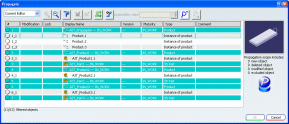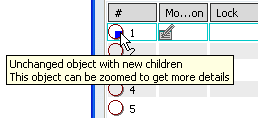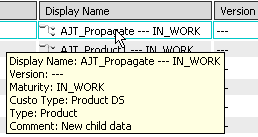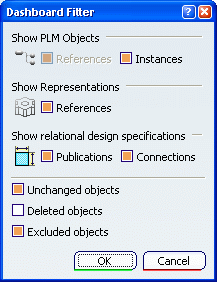Select
(or use Ctrl+Shift+S).
By default,
only references are listed:

Note:
When the Propagate dialog box opens, the West quadrant of the Compass is automatically selected in the active editor only (whatever the number of open editors):

When the dialog box is closed:
- If the West quadrant has not been deactivated, the Compass is restored to its previous state before the command was run.
- If the West quadrant has been deactivated, the Compass keeps its last activation state when the command ends. For instance, if the North quadrant is activated while the Propagate dialog box is open, then it will stay activated after the Propagate dialog box is closed. To restore the automatic West quadrant activation, select the West quadrant while the Propagate dialog box is open.
For more information about the Compass, see the Live ENOVIA V6 Connector User User's Guide: About the Compass.
In the Propagate dialog box, right-click anywhere then click Select All.
Click Zoom In
 (or use the Zoom In contextual command).
(or use the Zoom In contextual command).
All references are exploded:

The Propagate dialog box displays the objects in a single list so that:
- Objects are not mixed when they belong to two different editors that do not share any objects.
- Objects can be mixed when they belong to two different editors that share at least one object.
Optional: Point at the # or Display Name column.
A tooltip is displayed to provide useful information about the object to be propagated.


In the pulldown list to the left, select the propagation scope.
- The update status is computed on the current editor which means that the whole session might not be updated when selecting the Session propagation scope. In that case, a warning is displayed to recommend the use of the Propagate All... command to update all editors.
- The selected propagation scope is stored in preference files which means that it is retrieved from one session to another.
To exclude a reference, a representation reference or an
instance from the propagation scope, select
it then click Exclude from Propagation Scope .
.
You can also use the Exclude contextual command or double-click
the symbol in the Modification column.
in the Modification column.
Optional: When an object has been automatically excluded,
you can use the following two contextual commands:
- Exclusion Impact: lets you retrieve all the objects
that have been automatically excluded because of the excluded object you select. These objects are identified by the symbol
 .
.
- Exclusion Roots: lets you retrieve all the
excluded objects implying the automatic exclusion of the excluded
object you select. These objects are identified by the symbol
 .
.
Optional: To put an excluded object back to the
propagation scope, select it from the
list then click
Restore in Propagation Scope or use the Restore contextual command.
or use the Restore contextual command.
After its restoration, the object's modification mark  is restored.
is restored.
Note that
- When applied to a reference,
the restoration is also automatically applied to all its idirect children (instance,
representation, port or connection).
- Any unchanged reference can be restored when at least one of its direct children (instance, representation, port or connection) is excluded: all the excluded
direct children are restored as "To be propagated".
When the restoration is applied to a new aggregated representation, the reference is also impacted.
Click View Filter
 .
.
The Dashboard Filter dialog box lets you filter objects listed in the Propagate dialog box according to their status:

References are always displayed and this is why the References check box is selected and grayed out. You can customize the types to be displayed in the
Propagate dialog box through the
Propagation tab.
Optional: Select a modified object then
click Show Modifications
 .
.
The Logged modifications
dialog box displays the history of all the modifications made to the selected object since you opened it:

The data displayed in this dialog box is displayed for
information only.
Regarding 3D Parts, note that the dialog
box gives information on the global 3D Part, whatever the
modifications made to the reference or the representation.
In addition to this, note also that when creating a new 3D Part then propagating it, the creation and modification dates remain the same as the original product is not modified. For more information about this behavior, see About the V6 Data Model. To know what has been created or modified, you can use the # column which indicates if the reference and/or its aggregated objects are new or
modified.
To create a new version for a product or a
representation, select it then click New Major Version
 (or use the New Major Version contextual command).
(or use the New Major Version contextual command).
The new version symbol appears in the Version column and the
Applicability date box becomes activated to let you
enter the new applicability date (you can also click
 to select the date of your choice).
to select the date of your choice).
Inversely, to remove the new
version, click New Major Version
 again.
again.
For more information, see
VPM Navigator User's Guide: Versioning.
To change the maturity status of a product, a product
instance or a representation, select the desired objects then click Maturity Management
 (or use the Maturity Management contextual command).
(or use the Maturity Management contextual command).
For more information, see VPM Navigator User's Guide: Changing Maturity.
Optional: To create a new
copy of one or many objects, select them then click
Propagate as New
 .
.
Click OK to validate.
An easy warning similar to the one below is displayed in
the top right corner of the screen to give a status:








